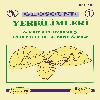The effect of mineralogical structure on the cyanidation of Gold ores
Altın cevherlerinin siyanür liçinde mineralojik yapının etkisi
___
- Adams, M.D., 2005. Advances in Gold Ore Processing, Developments in Mineral Processing 15, Elsevier.
- Alp, İ., Celep, O., Tüysüz, N., Vıcıl, M., Lermi, A., 2003. Effect on Ore Processing of Miner alo gical Structure: Model Study on Mastra and Kaletaş Gold Ores, Proc. of 18th. International Mining Congress and Exhibitions of Turkey, G. Özbayoğlu (ed.), 10-13, Turkey, (in Turkish).
- Cashion, J.D. and Brown, L.J., 1998. Gold Mineralogy and Extraction Hypeifine Interactions, 111, 271-280.
- Çubukçu, A. and Tüysüz, N., 2000. Origin of Kaletaş (Gümüşhane) Epithermal Gold Ore, Earth-sciences and Mining Congress, MTA, Turkey (in Turkish).
- Deschenes, G., McMullen, J., Ellis, S., Fulton, M. and Atkin, A., 2005. Investigation on the Cyanide Leaching Optimization for the Treatment of KCGM Gold Flotation Concentrate-phase 1, Minerals Engineering, 18,832-838.
- Gönen, N., 1999. Gold Recovery Using Cyanidation from Gümüşhane-Kaletaş Ore, M.T.A. Rap No:1324, Ankara, (in Turkish).
- Gönen, N., 2003. Leaching of Finely Disseminated Gold Ore with Cyanide and Thiourea Solutions, Hydrometallurgy, 69, 169-176.
- Gunyanga, F.P., Mahlangu, T., Roman, R.J., Mungoshi, J. and Mbeve, K., 1999. An Acidic Pressure Oxidation Pretreatment of Refractory Gold Concentrates from the Kwekwe Roasting Plant-Zimbabwe, Minerals Engineering, 12, 8, 863-875.
- Iglesias, N. and Carranza, F., 1994. Refractory Gold-Bearing ore: A Review of Treatment Methods and Recent Advances in Biotechnological Techniques, Hydrometallurgy, 34,383-395.
- La Brooy, S.R., Linge, H.G. and Walker, G.S., 1994. Review of Gold Extraction from Ores, Minerals Engineering, 7,10,1213-1241.
- Lehman, M.N., Oleary, S. and Dunn, J.G., 2000. An Evaluation of Pretreatments to Increase Gold Recovery from a Refractory Ore Containing Arsenopyrite and Pyrrhotite, Minerals Engineering, 13,1,1-18.
- Liipo, J., 2003. Characterization of the Mode of Occurrence of Gold in Jokisivu Pilot Feed and Products, Minerals Engineering, 16,1317-1321.
- Oktay, C., Özşuca, D. and Saklar, S., 2001. Gold Recovery Using Roasting and Cyanidation methods from Gümüşhane -Kaletaş Ore, M.T .A, Ankara, (in Turkish).
- Petruk, W., 1989. Recent Progress in Mineralogical Investigations Related to Gold Recovery, Minerals Engineering, 32, 37-39.
- Roshan, B. B., 1990. Hydrometallurgical Processing of Precious Metal Ores, Mineral Processing and Extractive Metallurgy Review, 6, 67-80.
- Rubisov, D.H., Papengelakis, V.G. and Kondos, P.D., 1996. Fundamental Kinetic Models for Gold Ore Cyanide Leaching, Canadian Metallurgical Quarterly, 35,4, 353-361.
- Sinadinovic, D., Kamberovic, Z. and Vakanjac, B., 1999. Refractory Gold Ores, Characteristics and Methods of Their Procession, VIII. Balkan Mineral Processing Conference Proceedings, Balkema.
- Tüysüz, N., Er, M., Yılmaz Z. and Akıncı, S, 1995. Geology, Mineralogy and Alteration of the Mastra Epithermal Gold-Silver Deposit, Gümüşhane, NE-Turkey, Turkish Journal of Earth Sciences, 4,11-21.
- Tüysüz, N., Özdoğan, K., Er, M., Yılmaz, and Z., Ağan, A., 1994. Carlin Type Kaletaş (Gümüşhane) Gold Deposit In Pontide Island Arc, Turkey Geology Bulletin, 37, 41-46 (in Turkish).
- Vıcıl, M. and Alp, İ., 2002. Comparison of Gold Particles Taken from Gold Deposits in Gümüşhane Region, Proceedings of the 1st Gümüşhane Development Symposium, Vol.1, ed. by Durmuş, A., (in Turkish).
- ISSN: 1019-1003
- Yayın Aralığı: 1
- Başlangıç: 1986
- Yayıncı: Çukurova Üniversitesi Jeoloji Mühendisliği Bölümü
Yusuf URAS, Fevzi ÖNER, Servet YAMAN
Van Gölü havzası neojen çökellerinin jeoteknik özelliklerine bir bakış: Erciş yerleşkesi
Ali ÖZVAN, M. Alper ŞENGÜL, Mucip TAPAN
Huzurkent (Tarsus) civarındaki Kuzgun formasyonu'nun ostrakod toplulukları ve ortamsal özellikleri
Yoğunoluk (Kadirli-Osmaniye) boksit yatağının petrografik ve jeokimyasal incelemesi
Yusuf URAS, Semiha İLHAN, Mustafa AKYILDIZ
Deterioration of tuffite and andesite stones monuments in urban areas (Niğde, central Turkey)
Aydın ÇOLAKOĞLU, Ender SARIFAKIOĞLU, Hayrettin ÖZEN, Hüseyin SAYAK
Sarıkavak (Mersin) manyezit yataklarının jeokimyasal incelemesi
Direct conversion of celestite ($SrSO_4$) to strontium carbonate by dry mechanochemical processing
Adana ili ana arterlerindeki toz ve gürültü emisyonunun değerlendirilmesi
